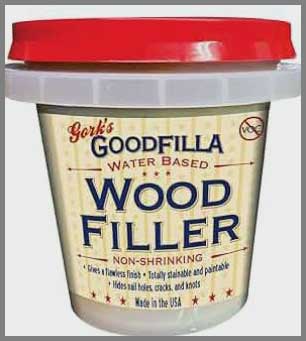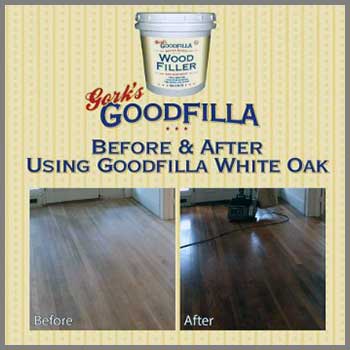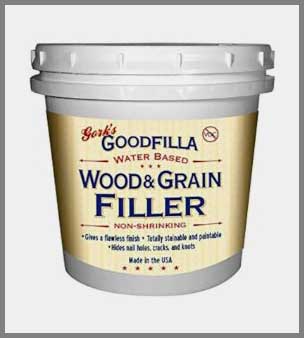
If you’re tackling a woodworking project, whether it’s patching up a cherished oak table or smoothing out floorboard imperfections, Goodfilla Wood Filler is your go-to solution.
I’ve used it extensively, and it’s a game-changer for seamless repairs. Its versatility, eco-friendly formula, and ability to blend with any wood type make it a must-have for DIY enthusiasts and professionals alike.
In this article, I’ll share my hands-on experience, break down its strengths and weaknesses, offer maintenance tips, and compare it to other brands, all while answering common questions to help you decide why Goodfilla deserves a spot in your toolkit.
My Experience With Goodfilla Wood Filler
Last summer, I decided to restore an old cedar chest that had been sitting in my garage, gathering dust and scratches. The chest had deep gouges, nail holes, and some unsightly cracks that screamed for attention. I’d heard about Goodfilla Wood Filler from a woodworking forum and decided to give it a shot. When the tub arrived, I was impressed by its hefty feel and the promise of a water-based, non-toxic formula. I chose the walnut shade to match the chest’s rich tone, and I was eager to see if it lived up to the hype.
Opening the tub, I noticed the filler’s clay-like consistency, which felt dense yet workable. I stirred it as instructed, adding a splash of warm water to get a smoother texture for smaller cracks. Applying it with a putty knife was a breeze; it spread evenly, filling nail holes and deep gouges with minimal effort. I was skeptical about its claim of no shrinkage, but after letting it dry overnight, the surface was rock-solid and level—no cracks or dips. Sanding was effortless, leaving a smooth finish that blended seamlessly with the cedar’s grain when I applied a dark stain.
What stood out was the versatility. I used the same tub to patch a pine bookshelf with tiny knots and a mahogany table with a chipped edge. Each time, Goodfilla adhered perfectly, and the color options made matching a cinch. The lack of odor was a relief, especially since I was working indoors without a mask. However, I did notice that the filler dried out in the tub if left open too long, so I learned to seal it tightly after each use. Overall, Goodfilla transformed my projects, making repairs look professional and saving me from replacing furniture.
Also read: My Thoughts on Quick-Step Laminate Flooring
Pros Of Goodfilla Wood Filler

- Versatile Application: Goodfilla works on everything from hardwood floors to delicate furniture, filling cracks, holes, and grain pores with ease. I used it on cedar, pine, and mahogany, and it bonded flawlessly each time.
- Eco-Friendly Formula: Being water-based and free of VOCs, it’s safe for indoor use without harsh fumes. I appreciated not needing a mask while working in my small garage.
- Customizable Consistency: You can adjust its thickness by adding water, making it perfect for both deep repairs and fine grain filling. This flexibility saved me from buying multiple products.
- No Shrinkage: Unlike other fillers I’ve tried, Goodfilla doesn’t shrink or crack as it dries. My cedar chest repair stayed level even after months of use.
- Stainable And Paintable: It accepts stains and paints well, blending seamlessly with wood grains. The walnut shade I used matched my chest perfectly after staining.
- Quick Drying: Most shallow repairs dry in 15-30 minutes, letting you sand and finish quickly. I was able to move on to staining my bookshelf the same day.
- Long Shelf Life: If it dries out, you can reconstitute it with water, reducing waste. I revived a half-used tub after weeks of neglect, and it worked like new.
These strengths make Goodfilla a standout. Its ability to handle diverse projects while being user-friendly and environmentally conscious is why I keep it on hand. The no-shrinkage claim held true across my repairs, and the customizable consistency meant I could tackle both intricate and heavy-duty tasks without switching products. Plus, the lack of toxic fumes made my workspace more pleasant, especially during long sessions.
Cons Of Goodfilla Wood Filler
- Not Ideal For Outdoor Use: Goodfilla absorbs water even after curing, making it unsuitable for outdoor projects exposed to rain. I learned this when a patio table repair softened after a storm.
- Inconsistent Container Quantities: Some users, including me, received tubs that weren’t filled to the brim, which felt like a rip-off. My second tub was noticeably short on product.
- Staining Challenges: While stainable, it can absorb stain unevenly, especially on larger patches. I had to apply a pre-stain conditioner to get consistent color on my mahogany table.
- Trowel-Ready Version Issues: The trowel-ready formula has a yellowish tint and a foul odor, unlike the heavy-body version. I accidentally ordered it once and regretted it instantly.
- Requires Careful Storage: If not sealed tightly, the filler dries out in the tub. I lost some product before learning to store it in an airtight container.
- Pricey For Large Projects: Compared to budget brands, Goodfilla is pricier, especially for big jobs. I felt the cost when filling deep holes in a large floorboard section.
Despite these drawbacks, Goodfilla’s issues are manageable with proper planning. For indoor projects, it’s still my top choice, but I’d hesitate to use it outside or for massive repairs without budgeting carefully. The staining inconsistency was a minor hassle, but a pre-stain conditioner solved it. Just be vigilant about storage and double-check which formula you’re buying.
Maintenance Tips For Goodfilla Wood Filler

- Seal The Container Tightly: Always close the tub immediately after use to prevent drying. I wrap the lid with plastic wrap for extra protection, keeping the filler fresh for months.
- Add Water To Reconstitute: If the filler hardens, mix in warm water gradually until it’s workable again. I revived a crusty tub this way, saving money and reducing waste.
- Apply In Layers For Deep Repairs: For holes deeper than a quarter-inch, apply thin layers, letting each dry fully. This prevented cracking when I filled a deep gouge in my cedar chest.
- Use A Pre-Stain Conditioner: To ensure even staining, apply a conditioner before staining large patches. This trick made my mahogany table repair blend perfectly.
- Store In A Cool, Dry Place: Keep the tub away from heat or humidity to maintain its consistency. I store mine in a basement cupboard to avoid temperature swings.
- Clean Tools Immediately: Rinse putty knives and cloths with water right after use to avoid hardened residue. I learned this after scraping dried filler off my favorite knife.
- Seal Exterior Repairs: If using outdoors, coat the repair with a weatherproof sealant or paint. This protected a deck rail repair from occasional rain, though I avoid constant exposure.
These tips ensure Goodfilla performs at its best. Proper storage and application techniques save time and product, while sealing and conditioning enhance durability and appearance. I’ve found that a little care goes a long way in making repairs last, especially for indoor furniture where Goodfilla shines.
Comparison With Other Brands
Minwax Stainable Wood Filler
Minwax is a household name in woodworking, and its stainable wood filler is a solid competitor. I’ve used it for small repairs like nail holes in oak trim, and its mud-like consistency makes it easy to apply with a putty knife. It dries quickly, often within 15 minutes, and sands smoothly, but I noticed a sandy texture up close, which can be a drawback for fine furniture. Minwax excels at staining, especially on oak, where it matches the wood’s color closely. However, it’s less versatile than Goodfilla, struggling with large holes or open-grain woods like walnut. It’s also pricier for small quantities, and I found Goodfilla’s no-shrinkage edge more reliable for deeper repairs.
Gorilla Wood Filler
Gorilla’s wood filler is another strong contender, known for its durability and adhesion. I used it to repair a chipped table leg, and its smooth, dense texture spread effortlessly. It dries in 15-30 minutes for shallow fills and holds up well indoors and outdoors when sealed. Compared to Goodfilla, Gorilla has better outdoor performance, but it’s harder to sand due to its rock-hard finish. Stainability is decent, but I needed a primer for consistent results. Goodfilla’s customizable consistency and eco-friendly formula give it an edge for indoor projects, though Gorilla’s strength makes it a go-to for heavy-duty fixes.
Bondo Wood Filler
Bondo is a beast for structural repairs, drying rock-hard in just 15 minutes. I tried it on a broken chair frame, and its two-part formula was incredibly strong. However, its chemical smell is unbearable indoors, and sanding is a chore due to its hardness. Unlike Goodfilla, Bondo doesn’t stain well, often requiring a primer, and its quick-drying nature makes it tricky to work with for beginners. Goodfilla’s odor-free, water-based formula is far more user-friendly, and its versatility for both small and large repairs makes it a better all-around choice for most woodworking tasks.
Elmer’s Carpenter’s Wood Filler
Elmer’s is a beginner-friendly option, perfect for small touch-ups like cracks or nail holes. I used its squeeze bottle to fill pine bookshelf knots, and its thick, toothpaste-like consistency was easy to apply. However, it takes 12-24 hours to dry, which slowed my projects compared to Goodfilla’s quick-drying formula. Elmer’s stains decently but struggles with larger repairs, often requiring multiple coats. Goodfilla’s ability to handle deep holes and its color variety outshine Elmer’s, though the latter is cheaper for minor fixes. For complex projects, Goodfilla’s performance and flexibility win hands-down.
DAP Plastic Wood-X
DAP’s Plastic Wood-X is great for paintable repairs, sanding smoothly and adhering well to most woods. I used it on a painted door frame, and it blended seamlessly after a coat of paint. Its thick consistency is similar to Goodfilla’s, but it lacks the same level of stainability, often drying too light. DAP is also less eco-friendly, with a slight chemical odor that requires ventilation. Goodfilla’s non-toxic formula and ability to reconstitute with water make it more practical for frequent use, especially for those prioritizing sustainability and versatility in their woodworking projects.
Read more: My Thoughts on Suncast Tremont Storage Shed
Frequently Asked Questions (FAQ)
Choosing the best wood filler depends on your project. For me, Goodfilla stands out for its versatility, eco-friendly formula, and no-shrinkage performance. It handles everything from nail holes to deep gouges and blends well with stains. Minwax is great for stainable oak repairs, while Gorilla excels for durable, outdoor fixes. Bondo is ideal for structural strength, and Elmer’s suits beginners with small projects. Goodfilla’s balance of ease, customization, and sustainability makes it my top pick for most woodworking tasks.
Goodfilla’s drying time varies by repair depth. Shallow fills, like nail holes, dry to the touch in 15-30 minutes, ready for sanding. Deeper repairs, like a half-inch gouge, take 2-6 hours to fully cure. I’ve found letting it sit overnight for thick applications ensures a solid finish. Temperature matters—keep it above 40°F for best results. Adding water to adjust consistency can slightly extend drying, but I’ve never waited more than a day, even for large patches.
Wood filler isn’t a fix-all. Avoid it for structural repairs, like a broken table leg, where glue or epoxy provides better strength. It’s also not ideal for gaps over an inch deep, as it can crack or take too long to dry. For outdoor projects with constant water exposure, like a submerged dock, Goodfilla’s water-absorbent nature makes it a poor choice unless heavily sealed. I learned this when a patio repair failed after heavy rain. Use it for cosmetic fixes, not load-bearing ones.
Using Goodfilla is straightforward. Stir the filler first; if it’s dry, add warm water to reach your desired consistency. For small holes, apply with a putty knife, pressing firmly to fill. For grain filling, thin it with water and use a damp cloth or squeegee. Apply deep repairs in layers, letting each dry fully. Smooth with a damp cloth or sand when dry. For exterior use, mix with weatherproof glue and seal with paint. I always test a small area first to ensure the color matches after staining.
Conclusion: For Goodfilla Wood Filler
Goodfilla Wood Filler is a must-buy for anyone serious about woodworking. Its versatility, eco-friendly formula, and seamless blending make it perfect for restoring furniture or fixing floors. From my cedar chest to pine shelves, it delivered professional results every time. Despite minor drawbacks like outdoor limitations, its strengths outweigh the cons. Whether you’re a DIY newbie or a seasoned pro, Goodfilla will elevate your projects. Grab a tub, and you’ll wonder how you ever managed without it.
